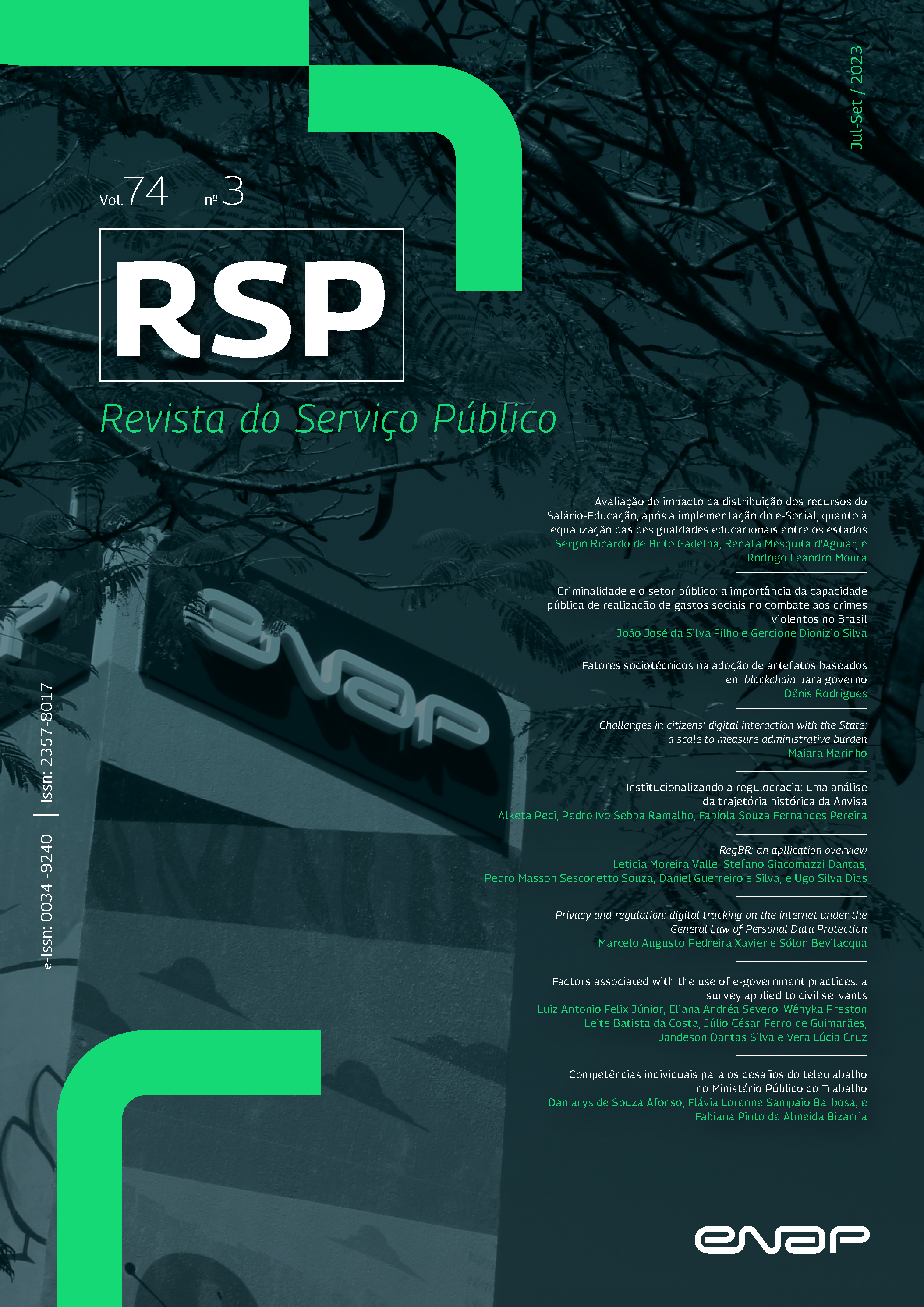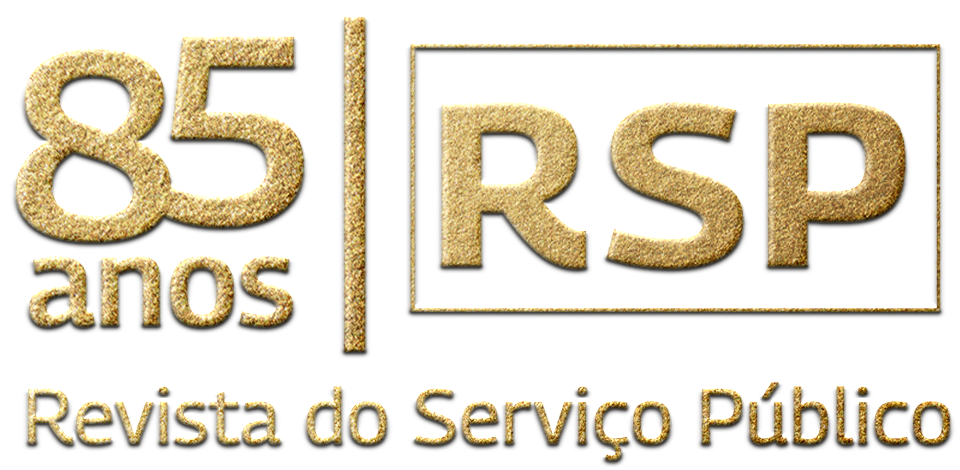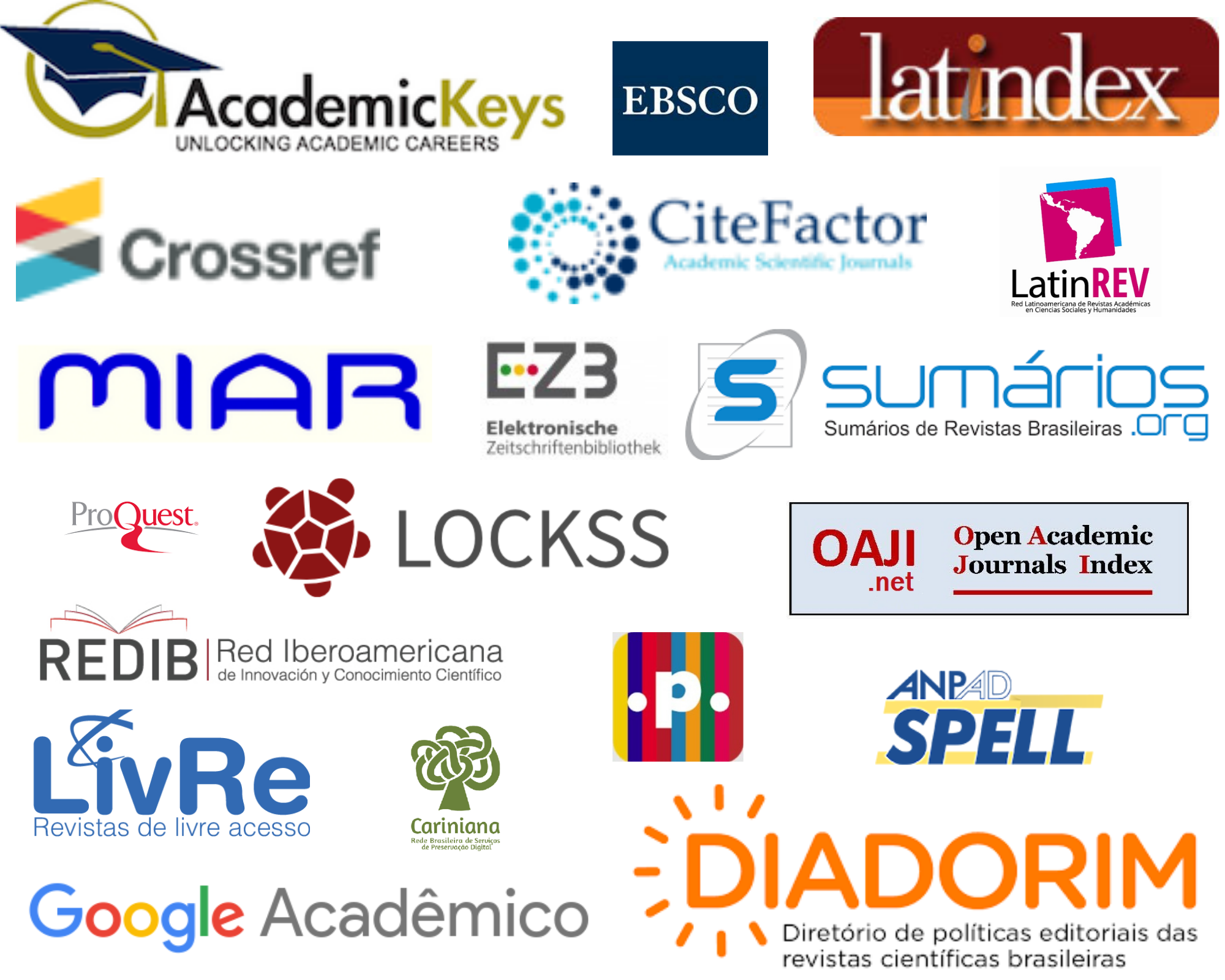RegBR: uma visão geral das aplicações
an application overview
Palavras-chave:
transparência, governo aberto, aprendizado de máquina, regulamentação governamental, processamento de linguagem natural (PLN)Resumo
A abertura e a transparência do governo são elementos-chave para construir um estado responsável e confiável, conceitos essenciais para o funcionamento das democracias e economias de mercado. A transparência nos processos governamentais aumenta a compreensão dos cidadãos e permite que eles se envolvam na supervisão e auditoria das ações governamentais. O RegBR foi concebido como um framework para melhorar a transparência legislativa, dando ao cidadão uma ferramenta para observar e monitorar o processo regulatório brasileiro e suas características. Nesse contexto, o RegBR utiliza informações estruturadas tanto para criar um fluxo regulatório histórico quanto para conceber diversas métricas regulatórias, que apresentam quão relevantes são os diferentes setores da economia, quão restritos são os atos normativos, quão linguisticamente complexas são as regulamentações e, por fim, quão populares são esses atos normativos pelos olhos do cidadão e para o governo.
Downloads
Referências
Abu-Shanab, E. (2015). Reengineering the open government concept: An empirical support for a proposed model. Government Information Quarterly, 32, 453-463. https://doi.org/10.1016/j.giq.2015.07.002
Aletras, N., Tsarapatsanis, D., Preotiuc-Pietro, D, Lampos, V. (2016). Predicting judicial decisions of the european court of human rights: A natural language processing perspective. PeerJ Computer Science, 2(e.93). https://doi.org/10.7717/peerj-cs.93
Allio, M. K. (2012). Strategic dashboards: Designing and deploying them to improve implementation.
Strategy & Leadership, Vol. 40 (5), 24-31. https://doi.org/10.1108/10878571211257159
Al-Ubaydli, O. & Mclaughlin, P.A. (2017). Regdata: A numerical database on industry-specific regulations for all united states industries and federal regulations, 1997–2012. Regulation & Governance, 109-123. https://doi.org/10.1111/rego.12107
Aronson, J., Brancalion, P.H.S., Durigan, G., Rodrigues, R.R., Engel, V.L., Tabarelli, M., Torezan, J.M.D., Gandolfi, S., De Melo A.C.G., Kageyama, P.Y., Marques, M.C.M., Nave, A.G., Martins,S.V.
, Gandara, F.B., Reis, A., Barbosa, L.M., Fabio R. Scarano, F.R. (2011). What role should government regulation play in ecological restoration? Restoration Ecology, 19, 690-695. https://doi.org/10.1111/ j.1526-100X.2011.00815.x
Banerjee, R. & Mio, H. (2018). The impact of liquidity regulation on banks. Journal of Financial Intermediation, 30-44. https://doi.org/10.1016/j.jfi.2017.05.008
Bertot, J. C., Jaeger, P.T. & Grimes, J. M. (2010). Using ICTs to create a culture of transparency: E-government and social media as openness and anti-corruption tools for societies. Government information quarterly, 264-271. https://doi.org/10.1016/j.giq.2010.03.001
Boella, G., Di Caro, L., Humphreys, L., Robaldo, L., Rossi, P. & Torre, L. (2011). Using classification to support legal knowledge engineers in the eunomos legal document management system. Fifth International Workshop on Juris-Informatics, 245-283. https://doi.org/10.1007/s10506-016-9184-3
Brown, A., Fishenden, J., Thompson, M. & Venters, W. (2017). Appraising the impact and role of platform models and Government as a Platform (GAAP) in UK Government public service reform: Towards a Platform Assessment Framework (PAF). Government Information Quarterly, 167-182. h https://doi. org/10.1016/j.giq.2017.03.003
Cary, C. (2012). Measuring regulatory performance – Evaluating the impact of regulation and regulatory policy. OECD Publishing.
Castro, M. (2014). New legal approaches to policy reform in Brazil. University of Brasília Law Journal, v. 1, n.01.
Chengalur-Smith, I.N., Ballou, D.P. & Pazer, H.L. (1999). The impact of data quality information on decision making: an exploratory analysis. IEEE Transactions on Knowledge and Data Engineering, 853- 86. https://doi.org/10.1109/69.824597
Coates, D. & Heckelman, J.C. (2003). Interest groups and investment: a further test of the Olson Hypothesis. Public Choice, 333-340. https://doi.org/10.1023/B:PUCH.0000003737.58212.a7
Coffey, B., McLaughlin, P.A. & Tollison, R.D. (2012). Regulators and redskins. Public Choice, 153, 191- 204. https://doi.org/10.1007/s11127-011-9781-3
Cover, T.M. & Thomas, J.A. (2005). Elements of information theory, Second Edition. John Wiley & Sons, Inc.
Crews, C. (2002). Ten thousand commandments: An annual snapshot of the federal regulatory state. Cato Institute.
Da Motta, R.S. & Moreira, A.R. (2006). Efficiency and regulation in the sanitation sector in Brazil. Utilities Policy, 14 (3), 185-195. https://doi.org/10.1016/j.jup.2006.03.002
Dredge, D., Gyimóthy, S., Birkbak, A., Jensen, T.E. & Madsen, A. (2016). The impact of regulatory approaches targeting collaborative economy in the tourism accommodation sector: Barcelona, Berlin, Amsterdam and Paris. Impulse Paper, n.9.
EGERT, B. & Wanner, I. (2016). Regulations in services sectors and their impact on downstream industries. The OECD 2013 regimpact indicator. Tech. rep., OECD.
Fishenden, J. & Thompson, M. (2013). Digital government, open architecture, and innovation: why public sector it will never be the same again. Journal of public administration research and theory, 977- 1004. https://doi.org/10.1093/jopart/mus022
Google. (2022). FAQ about Google Trends data. Available at: https://support.google.com/trends/ answer/4365533?hl=en. Last access on 30 May 2022.
IGBE. (2007). Introduction to the national classification of economic activities (CNAE). IBGE Repository,
v. 2.
IBM. (2018). The future of compliance: how cognitive computing is transforming the banking industry. Whitepaper.
Katz, D.M., Bommarito II, M.J. & Blackman, J. (2017). A general approach for predicting the behavior of the supreme court of the United states. PLOS ONE, 12, 1-18. https://doi.org/10.1371/journal. pone.0174698
Lodge, M., Van Stolk, C.V., Batistella-Machado, J., Schweppenstedde, D. & Stepanek M. (2017). Regulation of logistics infrastructure in Brazil. RAND.
Maheshwari, D. & Janssen, M. (2014). Dashboards for supporting organizational development: principles for the design and development of public sector performance dashboards. Proceedings of the 8th international conference on theory and practice of electronic governance, p. 178-185. https://doi. org/10.1145/2691195.2691224
Martins, A.R.S., Sanches, C.S. & Pinheiro, T.M.M. (2022). Iniciativas para a institucionalização do uso de evidências no processo regulatório na ANEEL - um estudo de caso de agência reguladora. In Políticas públicas e o uso de evidência no Brasil: conceitos, métodos, contextos e práticas, chapter 18. Brasília: IPEA.
Matheus, R., Janssen, M. & Maheshwari, D. (2020). Data science empowering the public: Data-driven dashboards for transparent and accountable decision-making in smart cities. Government Information Quarterly. https://doi.org/10.1016/j.giq.2018.01.006
Mcchesney, F. (1987). Rent extraction and rent creation in the economic theory of regulation. The Journal of Legal Studies,101-118. https://doi.org/10.1086/467825
Mcgovern, K. (2017). Regulatory analytics: Keeping pace with the SEC: Five insights into compliance. Delloite.
Mclaughlin, P.A., Sherouse, O. & Potts, J. (2019a). Regdata: Australia. Mercatus Center, Research Paper.
Mclaughlin, P.A., Strosko, s. & Jones, L. (2019b). Regdata Canada: A snapshot of regulatory restrictions in Canada’s provinces. Mercatus Center, Research Paper, George Mason University, Regulatory Snapshot.
Mitchell, V.L. & Zmud, R. Z. (1999). The effects of coupling it and work process strategies in redesign projects. Organization Science, 424-438. https://doi.org/10.1287/orsc.10.4.424
Mulligan, Casey & Shleifer, Andrei. (2005). The extent of the market and the supply of regulation.
Quarterly Journal of Economics, 120 (4), 1445-1473. https://doi.org/10.1162/003355305775097579
OECD. (2003). Regulatory performance: ex-post evaluation of regulatory policies. Proceedings from OECD expert meeting.
Orlikowski, W.J. & Barley, S.R. (2001). Technology and institutions: what can research on information technology and research on organizations learn from each other? MIS quarterly, V. 25 (2) 145-165. https://doi.org/10.2307/3250927
Parker, David C & Kirkpatrick, Colin. (2012). Measuring regulatory performance, The economic impact of regulatory policy: A literature review of quantitative evidence. OECD Publishing.
Peltzman, S. (1975). The effects of automobile safety regulation. Journal of political Economy, 677-725. https://doi.org/10.1016/0001-4575(76)90005-1
Pigou, A.C. (2013). The economics of welfare. Palgrave Macmillan,.
Leisen, R., Steffen, B. & Weber, C. (2019). Regulatory risk and the resilience of new sustainable business models in the energy sector. Journal of Cleaner Production, v. 219, 865-878. https://doi.org/10.1016/j. jclepro.2019.01.330
Robinson, D., Yu, H., Zeller, W.P. & Felten, E.W. (2008). Government data and the invisible hand. Yale JL
& Tech, v 11, p. 160.
Rowley, C.K, Tollison, R.D. & Tullock, G. (1988). The political economy of rent-seeking. Springer Science & Business Media.
Shim, D.C.& Eom, T.H. (2008). E-governmentandanti-corruption: empiricalanalysisofinternationaldata.
International Journal of Public Administration, 298-316. https://doi.org/10.1080/01900690701590553
Song, C. & Lee, J.. (2016). Citizens’ use of social media in government, perceived transparency, and trust in government. Public Performance & Management Review, 39 (2) 430-453. https://doi.org/10.1080/153 09576.2015.1108798
Stigler, G. (1971). The theory of economic regulation. The Bell Journal of Economics and Management Science, 2 (1) 3-21. https://doi.org/10.2307/3003160
Stiglitz, J.E. (1989). Markets, market failures, and development. The American Economic Review, 79 (2) 197-203.
Sulea, O., Zampieri, M. Vela, M. & Van Genabith, J. (2017). Predicting the law area and decisions of french supreme court cases. Proceedings of the International Conference Recent Advances in Natural Language Processing. RANLP, 716-722. https://doi.org/10.26615/978-954-452-049-6_092
Tuggener, D., Von Däniken, P., Peetz, T. & Cieliebak, M. (2020). Ledgar: A large-scale multi-label corpus for text classification of legal provisions in contracts. Proceedings of the 12th Language Resources and Evaluation Conference (LREC), 1228-1234. https://aclanthology.org/2020.lrec-1.155
Velcu-Laitinen, O. & Yigitbasioglu, O. (2012). The use of dashboards in performance management: Evidence from sales managers. International Journal of Digital Accounting Research, 12, 39-58. https:// doi.org/10.4192/1577-8517-v12_2
Vitale, C., Bitetti, R.. Danitz, E., Moiso, C. & Wanner, I. (2020). The 2018 edition of the oecd pmr indicators and database: Methodological improvements and policy insights. OECD Publishing. https://dx.doi. org/10.1787/2cfb622f-en
Wongchaisuwat, P., Klabjan, D. & McGinnis, J.O.. (2017). Predicting litigation likelihood and time to litigation for patents. Proceedings of the 16th edition of the International Conference on Artificial Intelligence and Law, 257-260. https://doi.org/10.1145/3086512.3086545
Yuan, L.; Wang, J., Fan, S., Bian, Y., Yang, B., Wang, Y. & Wang, X. (2019). Automatic legal judgment prediction via large amounts of criminal cases. IEEE 5th International Conference on Computer and Communications, 2087-2091. https://doi.org./10.1109/ICCC47050.2019.9064408
Downloads
Publicado
Como Citar
Edição
Seção
Licença
Copyright (c) 2023 Revista do Serviço Público

Este trabalho está licenciado sob uma licença Creative Commons Attribution-NonCommercial-ShareAlike 4.0 International License.
- A RSP adota a licença Creative Commons (CC) do tipo Atribuição – Uso Não-Comercial (BY-NC).
- A licença permite que outros remixem, adaptem e criem obra licenciada, sendo proibido o uso com fins comerciais.
- As novas obras devem fazer referência ao autor nos créditos e não podem ser usadas com fins comerciais, porém não precisam ser licenciadas sob os mesmos termos dessa licença.
- Ao publicar o artigo na RSP, o autor cede e transfere para a ENAP os direitos autorais patrimoniais referentes ao artigo.
- O artigo publicado na RSP não poderá ser divulgado em outro meio sem a devida referência à publicação de origem.
- O autor que tiver o artigo publicado na RSP deverá assinar o Termo de Concessão de Direitos Autorais (em momento oportuno a editoria da Revista entrará em contato com o autor para assinatura do Termo).



